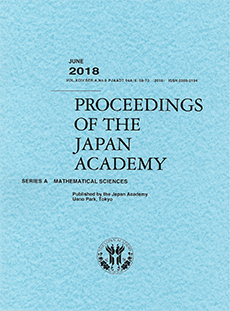Abstract
Let $\mathcal{M}$ be a maximal ideal of a commutative ring $R$ such that $\sharp(R / \mathcal{M}) < \infty$ and $\operatorname{char} R / \mathcal{M} \ne 2$. Denoting the $\mathcal{M}$-adic completion of $R$ by $R_{\mathcal{M}}$, we will show $H^1(g, SL_n(R_{\mathcal{M}}))$ vanishes for $g = \langle s \rangle$ acting on $SL_n(R_{\mathcal{M}})$ via $A^s = (A^{-1})^t$ where $t$ is the transpose operator.
Citation
Nicholas Hine Gajcowski. "Vanishing of certain cohomology sets for $SL_n(R_{\mathcal {M}})$." Proc. Japan Acad. Ser. A Math. Sci. 77 (10) 157 - 160, Dec. 2001. https://doi.org/10.3792/pjaa.77.157
Information





